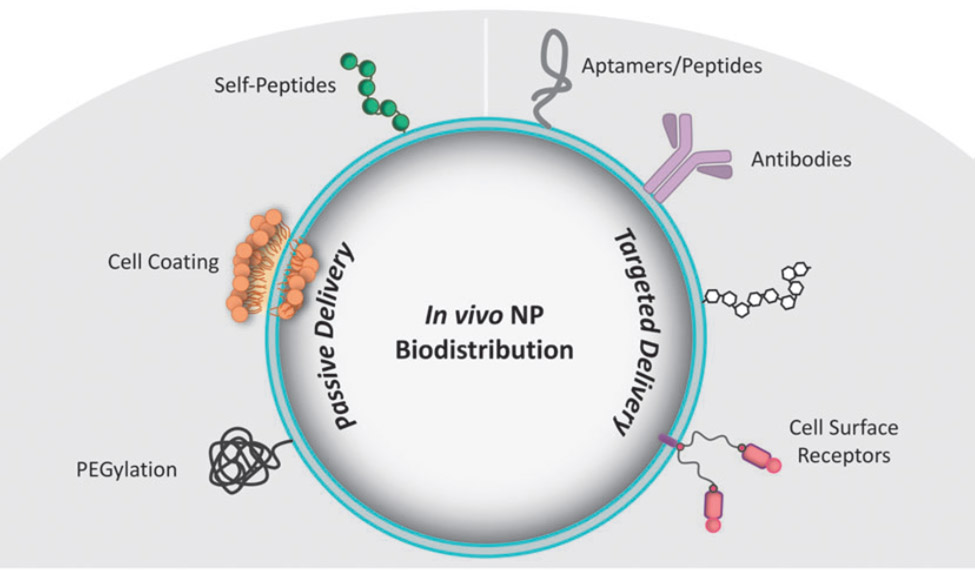| Jul 13, 2023 |
|
(Nanowerk News) Prosthetics moved by thoughts. Targeted treatments for aggressive brain cancer. Soldiers with enhanced vision or bionic ears.
|
|
These powerful technologies sound like science fiction, but they’re becoming possible thanks to nanoparticles.
|
|
And, as with any great power, there comes great responsibility.
|
|
“In medicine and other biological settings, nanotechnology is amazing and helpful, but it could be harmful if used improperly,” said Pacific Northwest National Laboratory (PNNL) chemist Ashley Bradley, part of a team of researchers who conducted a comprehensive survey of nanobiotechnology applications and policies.
|
 |
| Nanoparticles can be used as coatings to distribute biological applications through passive or targeted delivery. (Image: Shannon Colson, Pacific Northwest National Laboratory)
|
|
Their research, available now in Health Security (“The Promise of Emergent Nanobiotechnologies for In Vivo Applications and Implications for Safety and Security”), works to sum up the very large, active field of nanotechnology in biology applications, draw attention to regulatory gaps, and offer areas for further consideration.
|
|
“In our research, we learned there aren’t many global regulations yet,” said Bradley. “And we need to create a common set of rules to figure out the ethical boundaries.”
|
Nanoparticles, big differences
|
|
Nanoparticles are clusters of molecules with different properties than large amounts of the same substances. In medicine and other biology applications, these properties allow nanoparticles to act as the packaging that delivers treatments through cell walls and the difficult to cross blood-brain barrier.
|
|
“You can think of the nanoparticles a little bit like the plastic around shredded cheese,” said PNNL chemist Kristin Omberg. “It makes it possible to get something perishable directly where you want it, but afterwards you’ve got to deal with a whole lot of substance where it wasn’t before.”
|
|
Unfortunately, dealing with nanoparticles in new places isn’t straightforward. Carbon is pencil lead, nano carbon conducts electricity. The same material may have different properties at the nanoscale, but most countries still regulate it the same as bulk material, if the material is regulated at all.
|
|
For example, zinc oxide, a material that was stable and unreactive as a pigment in white paint, is now accumulating in oceans when used as nanoparticles in sunscreen, warranting a call to create alternative reef-safe sunscreens. And although fats and lipids aren’t regulated, the researchers suggest which agencies could weigh in on regulations were fats to become after-treatment byproducts.
|
|
The article also inventories national and international agencies, organizations, and governing bodies with an interest in understanding how nanoparticles break down or react in a living organism and the environmental life cycle of a nanoparticle. Because nanobiotechnology spans materials science, biology, medicine, environmental science, and tech, these disparate research and regulatory disciplines must come together, often for the first time—to fully understand the impact on humans and the environment.
|
Dual use: Good for us, bad for us
|
|
Like other quickly growing fields, there’s a time lag between the promise of new advances and the possibilities of unintended uses.
|
|
“There were so many more applications than we thought there were,” said Bradley, who collected exciting nanobio examples such as Alzheimer’s treatment, permanent contact lenses, organ replacement, and enhanced muscle recovery, among others.
|
|
The article also highlights concerns about crossing the blood-brain barrier, thought-initiated control of computers, and nano-enabled DNA editing where the researchers suggest more caution, questioning, and attention could be warranted. This attention spans everything from deep fundamental research and regulations all the way to what Omberg called “the equivalent of tattoo removal” if home-DNA splicing attempts go south.
|
|
The researchers draw parallels to more established fields such as synthetic bio and pharmacology, which offer lessons to be learned from current concerns such as the unintended consequences of fentanyl and opioids. They believe these fields also offer examples of innovative coordination between science and ethics, such as synthetic bio’s IGEM—student competition, to think about not just how to create, but also to shape the use and control of new technologies.
|
|
Omberg said unusually enthusiastic early reviewers of the article contributed even more potential uses and concerns, demonstrating that experts in many fields recognize ethical nanobiotechnology is an issue to get in front of. “This is a train that’s going. It will be sad if 10 years from now, we haven’t figured how to talk about it.”
|


